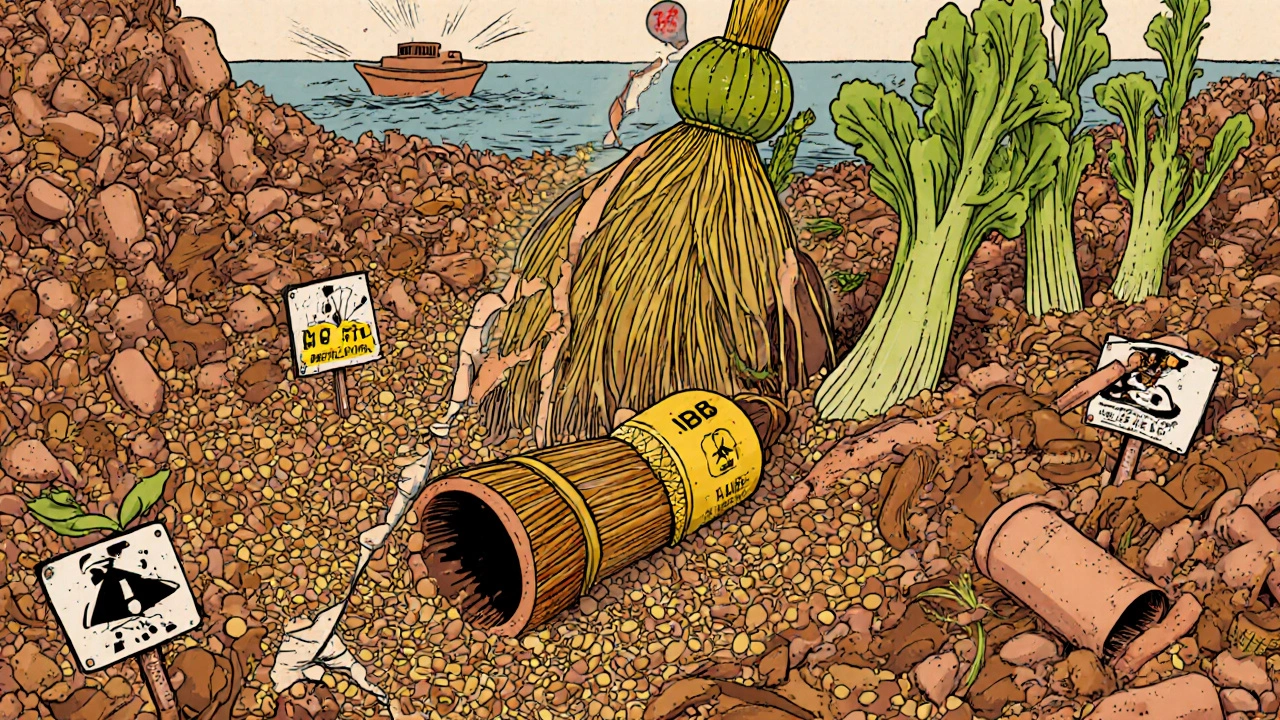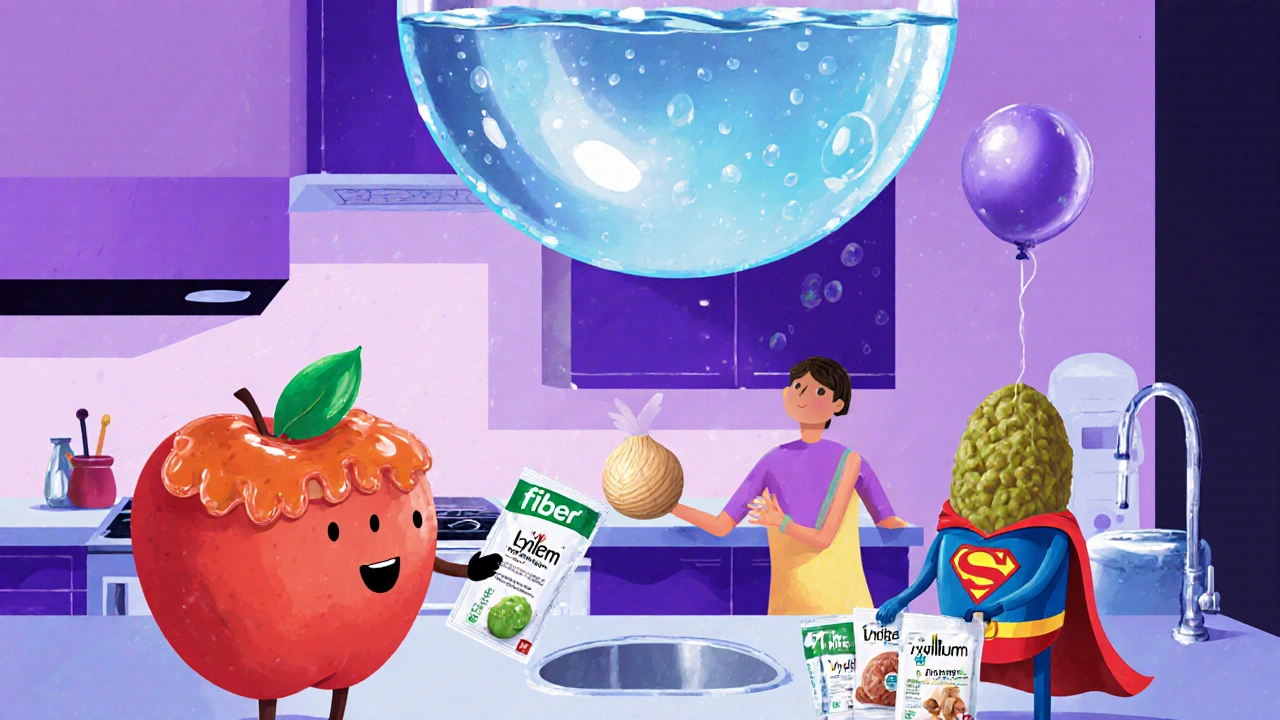Most people know fiber is good for digestion, but few understand soluble vs. insoluble fiber and how each actually works in your gut. If you’ve ever felt bloated after eating bran cereal or noticed your stool suddenly changed after adding chia seeds, you’ve felt the difference firsthand. The truth? You need both - but not in equal amounts, and not always at the same time.
What soluble fiber actually does in your gut
Soluble fiber doesn’t just pass through your system. It dissolves in water and turns into a thick, gel-like substance. Think of it like oatmeal soaking up water - that’s exactly what happens inside your intestines. This gel slows down digestion, which means sugar from your food enters your bloodstream more gradually. Studies show this can reduce post-meal blood sugar spikes by 20-30%. That’s why people with prediabetes or type 2 diabetes often feel more stable after switching to oatmeal, lentils, or apples instead of white bread.But the real magic happens in your colon. Gut bacteria feast on soluble fiber, breaking it down into short-chain fatty acids - especially butyrate. This isn’t just fuel; it’s medicine for your intestinal lining. Butyrate helps repair damaged cells, reduces inflammation, and even strengthens the barrier between your gut and the rest of your body. Research from 2024 confirms that soluble fiber directly boosts the good bacteria linked to better mood and mental clarity, thanks to the gut-brain connection.
It’s also the reason soluble fiber helps with both constipation and diarrhea. The gel adds structure to loose stools and softens hard ones. That’s why psyllium husk and ground flaxseed are often recommended for IBS - they don’t irritate, they regulate.
What insoluble fiber actually does in your gut
Insoluble fiber is the opposite. It doesn’t dissolve. It doesn’t turn to gel. It’s more like a sponge that soaks up water and pushes things along. Think of it as nature’s broom. It adds bulk to your stool - up to 50% more - and speeds up transit time through your digestive tract by 24 to 48 hours. That’s why whole grains, wheat bran, and raw vegetables are so effective for chronic constipation.Insoluble fiber is mostly made of cellulose and lignin - the tough parts of plants that your body can’t break down. That’s also why you sometimes see bits of corn or sesame seeds in your stool. They’re not passing through undigested because your body is broken; they’re doing their job. They’re sweeping waste out.
But here’s the catch: too much insoluble fiber during a flare-up of Crohn’s disease or ulcerative colitis can make things worse. It’s abrasive. It can irritate already inflamed tissue. That’s why doctors often recommend limiting high-fiber veggies, nuts, and seeds during active IBD episodes. Once things calm down, you slowly reintroduce them.
Which foods give you what kind of fiber?
You don’t need supplements to get both types. Real food already has them - usually in a mix. But some foods are heavy on one side:- Soluble fiber stars: Oats (1-2g per 100g), lentils (2-3g), black beans (5-8g), chia seeds (5.6g per 30g), apples (1.4g per medium), carrots (0.7g), and psyllium husk (7g per tablespoon).
- Insoluble fiber stars: Whole-wheat flour (7.9g per 100g), wheat bran (12g), almonds (3.5g per 30g), broccoli stems, kiwi skin (2.5g per fruit), and popcorn (1.2g per cup).
Most whole foods have both. A pear has soluble fiber in the flesh and insoluble in the skin. A bowl of brown rice gives you insoluble from the bran and some soluble from the grain itself. The key is variety.

Why the ratio matters - and what experts recommend
The Mediterranean diet doesn’t just say “eat more plants.” It gives you a pattern: lots of legumes, whole grains, vegetables, fruits, nuts, and seeds - all in balance. Studies show this diet delivers about 30-50g of total fiber daily, with a rough 3:1 ratio of insoluble to soluble. That’s not an accident. It’s what your gut evolved to handle.Harvard’s Dr. David Ludwig says soluble fiber’s gel-forming power is unmatched for heart health - eating 10g a day can drop LDL cholesterol by 5-10%. Meanwhile, Dr. Robynne Chutkan, author of The Fiber Effect, points out that insoluble fiber cuts your risk of diverticulosis by 40% over time. Both are vital.
But here’s the problem: most people eat 15g of fiber a day - less than half the recommended 25-38g. And when they do try to increase it, they go too fast. A Reddit thread from early 2023 showed that 45% of people who suddenly added fiber supplements or bran cereal ended up bloated, gassy, or even constipated. Why? No water.
How to actually increase fiber without feeling awful
You don’t need to overhaul your diet overnight. Here’s how real people do it successfully:- Start by adding 5g of extra fiber per week. That’s one extra serving of beans, or a tablespoon of chia seeds in your yogurt.
- Drink at least 1.5-2 liters of water every day. Fiber needs water to work. Without it, it just hardens and causes blockages.
- Swap refined grains for whole ones. Choose brown rice over white, whole-wheat bread over white, and oatmeal over sugary cereal.
- Keep the skins on fruits and veggies. Kiwi skin? Eat it. Potato skin? Leave it on. That’s where much of the insoluble fiber lives.
- Include at least one legume per day. Lentils, chickpeas, black beans - they’re fiber powerhouses with soluble and insoluble in one package.
If you have IBS, start with low-FODMAP soluble sources like oats, carrots, and psyllium. Avoid high-insoluble foods like raw broccoli and nuts until you’re stable. If you have IBD, follow your doctor’s advice - during flare-ups, focus on cooked vegetables and peeled fruits, and delay nuts and seeds.

Supplements vs. whole foods - what really works
The fiber supplement market is worth over $3 billion. But here’s the truth: pills can’t replace food.When you eat a bowl of lentils, you get fiber, plus magnesium, iron, antioxidants, and plant proteins. All of them work together. Isolated fiber powders? They just give you the fiber. No bonus nutrients. No synergy. No gut microbiome diversity boost.
Research from late 2024 confirms that whole foods produce 3-4 times more beneficial short-chain fatty acids than supplements. Even the most expensive psyllium capsules don’t match the effects of eating a daily serving of beans.
There’s one exception: psyllium husk. It’s the only supplement proven to help with both constipation and diarrhea, and it’s backed by clinical trials. But even then, it’s best used as a bridge - not a replacement - while you build up your whole-food intake.
What’s next? Personalized fiber
Companies like Zoe and Viome are now testing your gut bacteria to see how you respond to different fibers. One person might get a huge boost in good bacteria from oats, while another sees no change but thrives on flaxseed. In five years, your doctor might not just ask how much fiber you eat - they’ll ask which kind and how your gut reacted.For now, the best advice is simple: eat more plants. Mix your sources. Drink your water. Go slow. And remember - your gut isn’t just digesting food. It’s talking to your brain, your immune system, and your heart. Fiber is the language.
Can soluble fiber help with IBS?
Yes, soluble fiber often helps IBS by regulating stool consistency. Foods like oats, psyllium, and peeled apples can reduce both diarrhea and constipation. But avoid high-FODMAP soluble fibers like beans or lentils during flare-ups unless well-tolerated. Start low and increase slowly.
Does insoluble fiber cause bloating?
It can - especially if you increase intake too fast or don’t drink enough water. Insoluble fiber adds bulk, but without water, it can harden and slow things down. Start with small amounts of whole grains or vegetables and pair them with at least 2 liters of water daily.
Which fiber is better for weight loss?
Soluble fiber helps more directly. It slows digestion and triggers hormones that make you feel full longer - up to 25% more satiety, according to 2024 research. Foods like chia seeds, legumes, and apples keep you satisfied between meals, reducing overall calorie intake.
Can I get enough fiber on a low-carb diet?
Yes, but you need to be strategic. Focus on non-starchy vegetables (broccoli, spinach, zucchini), nuts (almonds, walnuts), seeds (chia, flax, sunflower), and avocado. These provide insoluble and some soluble fiber without spiking blood sugar. Aim for at least 20g daily - it’s possible without grains or legumes.
Is fiber safe during pregnancy?
Absolutely. Fiber helps prevent pregnancy-related constipation and may lower the risk of gestational diabetes. Stick to whole foods: fruits, vegetables, oats, lentils, and chia seeds. Drink plenty of water - 2.5 liters a day is ideal. Avoid fiber supplements unless advised by your doctor.
What happens if I don’t get enough fiber?
Low fiber intake is linked to constipation, hemorrhoids, diverticulosis, and higher risk of colon cancer. It also reduces good gut bacteria, which affects immunity and even mood. Most people consume only 15g daily - half the minimum needed. The long-term cost isn’t just digestive discomfort - it’s increased risk of chronic disease.


Jennifer Walton
Soluble fiber is just nature’s slow drip feed for your gut. Not magic. Just biology.
Kihya Beitz
Oh wow, another ‘eat more plants’ sermon. 🙄 I ate chia seeds for a week and turned into a gas-powered lawnmower. Thanks, science.
Hollis Hollywood
I really appreciate how this breaks down the science without oversimplifying. I used to think fiber was just ‘roughage’ - like something your body throws away. But learning how soluble fiber feeds your gut bacteria and produces butyrate? That changed everything for me. I started adding oats and psyllium slowly, and within a month, my bloating dropped and my energy felt more stable. It’s not just about digestion - it’s like your gut becomes a quiet, well-tuned engine. I wish more people understood that fiber isn’t a fix-all, but a foundation. And yeah, water matters. A lot. I learned that the hard way.
Aidan McCord-Amasis
Insoluble fiber = nature’s toilet brush. 🚽💪
Chris Bryan
They say ‘eat more fiber’ like it’s some government plot. Who’s really behind this? Big Oat? Big Chia? They want you dependent on their ‘healthy’ powders so you stop buying real food. And don’t get me started on ‘gut-brain connection’ - that’s just woke pseudoscience dressed up in lab coats.
Jonathan Dobey
The real tragedy isn’t low fiber intake - it’s the collective amnesia of the Western palate. We’ve replaced the symphony of phytonutrients, lignins, and fermentable polysaccharides with the tinny cacophony of processed carbs. Your gut isn’t a sewer - it’s a cathedral. And you’re sweeping leaves into it with a plastic broom labeled ‘bran cereal.’ The butyrate you’re missing? That’s the incense of a thriving microbiome. And no, psyllium capsules won’t bring back the sacred dance of co-evolved flora. You can’t supplement your way out of cultural decay.
John Foster
There’s something profoundly lonely about the modern relationship with food. We treat nutrition like a math problem - grams, ratios, targets - as if the body is a machine that just needs the right bolts. But your gut isn’t a gearbox. It’s a living ecosystem shaped by millennia of evolution, seasonal rhythms, ancestral diets, and quiet, unmeasured rituals. I used to track my fiber like a spreadsheet. Then I started eating meals slowly, without screens, and just… listening. The bloating didn’t vanish because I hit 30g - it vanished because I stopped fighting my body and started honoring it. That’s the part no study mentions. The silence between bites matters more than the numbers.
Edward Ward
This is one of the most balanced, well-researched takes on fiber I’ve seen in years - thank you. I especially appreciate how you clarified that insoluble fiber isn’t ‘bad’ during IBD flare-ups - it’s just abrasive, and context matters. I’ve seen so many people get scared off fiber entirely after one bad experience, and that’s tragic. The key is pacing, hydration, and individual tolerance - not blanket rules. Also, the point about whole foods producing 3-4x more SCFAs than supplements? That’s huge. I used to buy those expensive fiber powders until I realized I was paying for a single ingredient while ignoring the entire orchestra. Now I just add flax to my smoothies, eat the skin on apples, and snack on almonds. Simple. Sustainable. Real.
Andrew Eppich
While the article contains some factual information, it lacks proper citation of peer-reviewed sources. The claims about butyrate and mood are speculative without referencing specific studies. Additionally, the recommendation to consume 25-38g of fiber daily is based on outdated guidelines from the Institute of Medicine, which have been challenged by recent meta-analyses. The emphasis on whole foods is correct, but the tone is overly prescriptive and ignores individual metabolic differences. A more cautious, evidence-based approach would serve readers better.